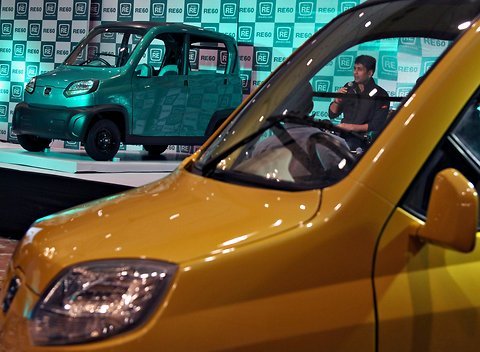 |
| Manish Swarup/Associated Press Rajiv Bajaj with the RE60 on Tuesday. |
India has a new ultracheap small car.
Well, sort of.
The company that introduced it on Tuesday, Bajaj Auto, best known for making motorcycles and motorized three-wheeled rickshaws, does not even call its newest product, the RE60, a car. Bajaj (no relation to the reporter) prefers the generic term four wheeler.
Executives say they have no plans to market it to average consumers. Instead, they are aiming for drivers of rickshaws, which are powered by motorcycle engines and operate as short-distance taxis in India. The RE60 offers features not found on current rickshaw models, including seat belts, doors and a hard top. It will have windows, although ones that fold out rather than roll down.
The company did not say how much the RE60 would cost when it hit showrooms this year. But a rickshaw costs about 120,000 rupees, or $2,200, and one auto analyst estimated that the RE60 would be priced 25 percent higher than that, or about $2,750.
But the RE60 was expected to be more than a souped-up rickshaw. It was widely anticipated as Bajaj’s answer to the Tata Nano. The Nano, which its maker Tata Motors introduced in 2009, was billed as a people’s car that would bring mobility to India’s masses. It sells for a list price of about $2,600.
But the analyst, Hormazd Sorabjee, said the RE60 would pose no challenge to the Nano, which itself had attracted only a fraction of the buyers for which Tata had hoped because of production delays and safety concerns.
“After seeing the RE60, you realize what a phenomenal achievement the Nano is,” said Mr. Sorabjee, editor of Autocar India, an automotive magazine. The RE60 “is nowhere near a full-sized car which the Nano is. Clearly it’s just not got the sophistication of the Nano.”
But executives from Bajaj suggested that was essentially the point — to make the best vehicle possible and not stretch to produce an engineering marvel that might not be suited to real-life conditions.
“At Bajaj Auto, we believe the people of this planet deserve much better, much faster,” Rajiv Bajaj, the managing director of the company said in a statement, in what appeared to be a not-so-subtle dig at the Nano. “We, therefore, decided to focus our efforts on developing vehicles powered by engines using available natural resources and infrastructure.”
 |
| B Mathur/Reuters The RE60 is aimed at drivers of rickshaws. |
Bajaj said the RE60, fitted with a one-cylinder, 200 cc engine, would deliver 35 kilometers per liter, or 82 miles per gallon, and have a top speed of 70 kilometers per hour, or 43 miles per hour .
At a news conference in New Delhi ahead of the Delhi AutoExpo, the country’s biggest car show, Mr. Bajaj told reporters that while he would be happy to sell the RE60 to consumers, his main target market was rickshaw drivers, who earn about $100 a month driving people short distances.
The RE60 is the result of several years of work by the company, which has an agreement to make a small car for the Renault-Nissan Alliance. Mr. Bajaj told reporters that those companies would get to see the RE60 this week at the AutoExpo and had the right to “walk away” if they did not like it.
In New Delhi, several rickshaw drivers expressed ambivalence about the RE60 on Tuesday afternoon, saying they did not see much benefit in upgrading to four wheels.
Suran Singh, 40, who has been driving a rickshaw for 26 years, said doors and a hard top would help keep out the cold during the winter, but would make him too hot in the scorching New Delhi summers.
“This is better to drive in hot weather because it’s cloth,” he said, pointing to the top of his green and yellow rickshaw. “In Delhi, it gets hot in the summer, and we’ll be sweating it out in a car.”

